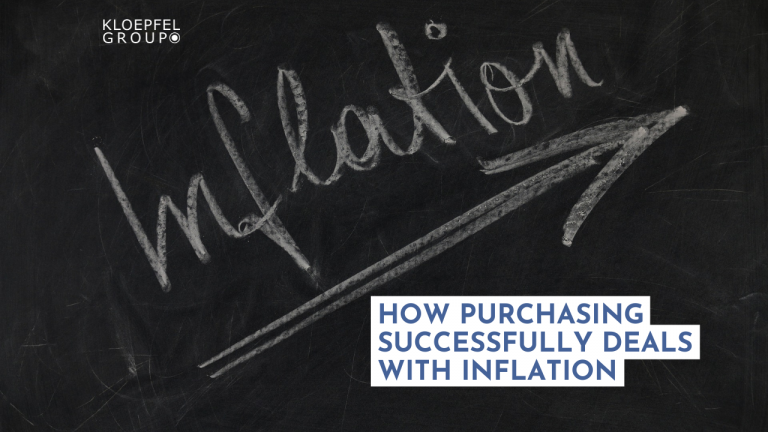How purchasing successfully deals with inflation
Author Thomas Wandler, Senior Partner at Kloepfel Consulting
Whether electricity, cotton or wood, almost everything that companies need for production processes is currently becoming more expensive. In many cases, this means that the company’s own margins are shrinking considerably. However, this development is not unavoidable. You can counteract it by taking the right measures in purchasing. Sometimes it is even possible to turn the tables. Inflation then turns from a margin eater into a margin driver.
Here you will find tips on how to proceed correctly and which purchasing decisions are particularly important.
The impact of inflation on various industries – examples
No industry in the DACH region is immune to inflation. However, it has different effects. Among other things, characteristics such as the size and market power of companies influence how well they succeed in absorbing or passing on increased costs.
Here are a few examples:
- Textile industry: The fact that prices on clothing and accessories have still remained unchanged in many places is primarily due to one reason: Raw materials such as cotton are purchased far in advance in the textile industry.
Nevertheless, the ever-increasing costs of materials, energy and personnel will also have an impact here. For suppliers of luxury goods and slow fashion, this is less of a problem. This is because their customers often remain loyal to them even when prices rise. The situation is different in the fast fashion sector.
- Food: Large food companies such as Nestle and Unilever have already made their products significantly more expensive. In this segment, too, it can be observed that price increases have comparatively little impact on sales of particularly expensive foods.
- Pharmaceutical industry: Because drug prices are regulated by the government in many countries, pharmaceutical companies cannot simply pass on increased costs to their customers. In some cases, however, they benefit from long-term agreements with suppliers. One decisive factor for the future will be how labor costs develop.
- Construction industry: Hardly any other industry is as dependent on the cost and availability of materials as the construction industry. Whether and to what extent price increases can be passed on in the short term here depends on the trade as well as the company’s own position on the market.
What companies can do to protect their margins
When the costs of raw materials, personnel and energy rise, price increases are inevitable. But depending on when and how they are implemented, they often only offset a small part of the additional costs.
So is the only thing left for companies to do is to come to terms with falling margins and wait for better times? Fortunately, not. You can prevent sales losses even during inflation by adopting a clever purchasing policy.
The following measures are particularly important in this context:
1. Speed up processes
During inflation, everything happens very quickly. There is a risk that today’s prices of your offers will be outdated tomorrow.
Therefore, speed up your sales processes. Make sure that sales can create offers that correspond to the current replacement prices. Analyze price trends at short intervals so that sales can act quickly and initiate price rounds with customers. Try to get in front of the wave instead of chasing it. Smooth information systems play a key role in this.
Tip: For analyses, it is advisable to create trend sheets that show past price developments and those expected in the future. Take indirect procurement issues such as transport costs into account.
2. Seek joint solutions with suppliers
Even with a favorable development, inflation is likely to continue for quite some time. It is best for purchasing to prepare for this and negotiate with suppliers to see if additional costs can be offset to some extent, for example by optimizing delivery terms. Use options to share rising costs. Of course, all this only works if purchasing is proactive and does not act too much from the defensive.
3. Calculate based on replacement costs
Change the price calculation so that it is no longer based on historical procurement costs, but on replacement costs. In this context, it is also crucial to analyze price increases regularly and thoroughly.
4. Install close coordination between purchasing and sales.
Ensure smooth coordination between purchasing and distribution. The closer the two work together during inflation, the better. For example, purchasing can support sales with in-depth market knowledge. It can provide them with coherent arguments to convincingly defend price increases and ensure that customers accept them.
5. Get external support
Expert knowledge from outside helps to analyze trends and streamline processes. In addition, many companies benefit from consulting on how to argue for price increases. After all, most managers today have little to no experience with a situation like this. After all, fortunately, the last comparable inflation was several decades ago.
How much of the increased costs can companies pass on to customers?
The answer is: It depends – not least on how your company, and especially your purchasing department, deals with the current situation. If you react quickly and succeed in analyzing cost drivers and price trends with foresight, installing a transparent pricing policy and supporting price increases to customers with coherent chains of argument, you will be in a different starting position than if you run after the development and enter negotiations with delayed and all-over price increases.
Conclusion – the right purchasing policy makes the difference
Inflation is a major challenge, especially for medium-sized companies. Yet there are ways to prevent inflation from eating into your margins. With the right purchasing policy, you can cushion the impact. Sometimes you can not only protect your own margins, but even increase them, and that during difficult times.
Contact:
Kloepfel Group
Christopher Willson
Tel.: 0211 941 984 33
Pempelforter Str. 50
40211 Duesseldorf
Mail: rendite@kloepfel-consulting.com
